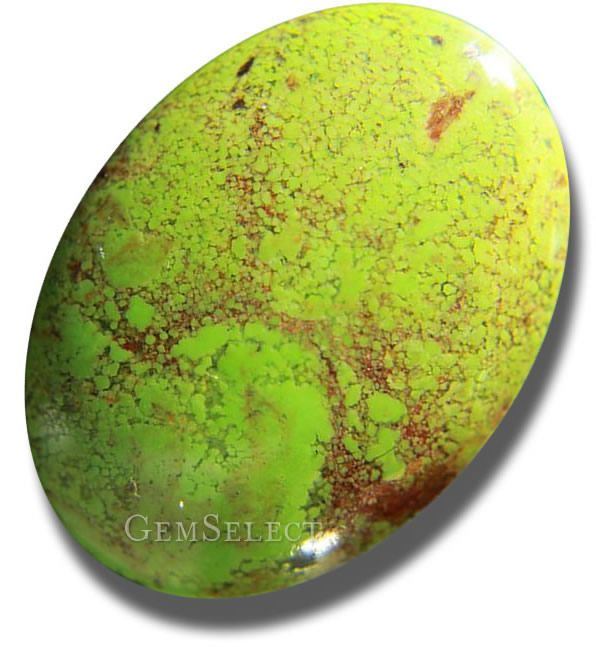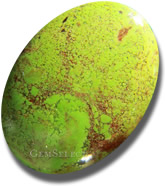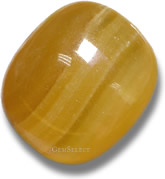Gaspeite Gemstone Information

About Gaspeite - History and Introduction
Gaspeite is considered to be one of the newer gemstones on the market. It was named after the Gaspé Peninsula of Quebec, Canada; the location of where it was first described and discovered in 1977. The discovery of gaspeite is credited to renowned American mineralogists, D.W. Kohls and J.L. Rodda.
Gaspeite is an extremely rare nickel carbonate mineral, which belongs to the calcite group of minerals. Initially, it was discarded as a worthless byproduct of nickel sulfide mining. Most gem-quality specimens available today are sourced from Western Australia or New Mexico, USA. Gaspeite is typically pale green to bright apple-green in color, often accompanied by brownish veins of rock that run through the material at various depths. Gaspeite has recently become very popular among gem and mineral collectors, mostly credited to its rarity and its slight similarity in appearance to rare green turquoise.
|
|

|
Gaspeite is a nickel magnesium iron carbonate and can be identified by its carbonate composition. Gaspeite belongs to a group of related isomorphous carbonate minerals that share many physical qualities. Gaspeite is quite dense with a specific gravity roughly the same as garnet. Its hardness is similar to that of apatite, ranging between 4.5 and 5 on the Mohs scale. Gaspeite exhibits perfect cleavage in 3 directions and can often be distinguished by its bright apple green color, brownish veiny inclusions and dull to vitreous luster.
Gaspeite is known to occur in a small number of locations around the world. Some of the more significant deposits are found in New Mexico, USA; Kambalda and Widgiemooltha of Western Australia; Tasmania, Australia, New South Wales, Australia; Sardinia, Italy; Lavrion, Greece; the Eugenia Mine in Spain and the Limpopo region of South Africa.
Gaspeite Color
Gaspeite is most famous for its apple green color, but its color can range from pale green to bright yellowish green. Most will exhibit brownish veins.
Gaspeite Clarity and Luster
Gaspeite crystals are typically translucent, but when found in its natural state, gaspeite is opaque. Most specimens will exhibit brownish veiny inclusions of rock. When cut and polished, gaspeite can exhibit a vitreous to dull luster.
Gaspeite Cut and Shape
Gaspeite is typically shaped and polished as cabochons. On rare occasions, it may be faceted for collectors or for display purposes. Gaspeite is often carved into ornamental designs and traded in rough crystal form or slices. The most common shapes are plain-cut ovals, rounds and cushions. Fancy shapes are quite rare, as are calibrated sizes.
Gaspeite Treatment
Gaspeite is not known to be treated or enhanced in any way.
| Chemical Formula: |
(Ni,Mg,Fe2+)CO3; Nickel carbonate |
| Crystal Structure: |
Trigonal |
| Color: |
Green, light-green, yellowish-green |
| Hardness: |
4.5 to 5 on the Mohs scale |
| Refractive Index: |
1.61 to 1.81 |
| Density: |
3.71 |
| Cleavage: |
Good |
| Transparency: |
Translucent to opaque |
| Double Refraction |
0.22 |
| Luster: |
Vitreous to dull |
| Fluorescence: |
None |
Please refer to our Gemstone Glossary for details of gemology-related terms.
 |
| Calcite Cabochon |
Gaspeite is a member of the calcite group of minerals, which includes several other carbonates with similar physical aspects, of which calcite is the most well-known. Most calcite matter does not form with clean, transparent gem-quality material, thus the lack of gemstone value. There are not many related gemstones on the market today, although there are many that are similar in appearance.
Most Popular Similar Gemstones:
Chrysoprase, calcite, chrysocolla, jade, malachite and turquoise are some of the more popular similar gemstones.
Lesser-Known Similar Gemstones:
Serpentine, variscite and verdite are lesser-known similar gemstones.
Gaspeite - Metaphysical and Crystal Healing Properties Back to TopGaspeite has long been used by Australian Aboriginals to help them to experience visions. This yellow-green stone is believed to possess very strong healing attributes. It is also thought to benefit those struggling with weight loss. It is a highly spiritual stone which can aid in contacting or communicating with other worlds. Gaspeite has a very grounded energy and is believed to provide strong vibrations that can benefit the heart and solar plexus chakras.
| Disclaimer: Metaphysical and Alternative Crystal Healing Powers and Properties are not to be taken as confirmed advice. Traditional, Ceremonial and Mythological Gemstone Lore is collected from various resources and is not the sole opinion of SETT Co., Ltd. This information is not to replace the advice of your doctor. Should you have any medical conditions, please see a licensed medical practitioner. GemSelect does not guarantee any claims or statements of healing or astrological birthstone powers and cannot be held liable under any circumstances. |
Gaspeite is a not a well-known gemstone and is most often cut into cabochons and beads for jewelry, or cut and polished for collectors only. Its rarity makes it a gem that will not be found in local jewelry stores. Since gaspeite is a slightly soft gemstone, it is not recommended for rings unless well-protected by a bezel setting. You will most often see gaspeite in beaded jewelry or set in pins or pendants. Since the more recent discovery of a large gaspeite deposit in Australia, it has become more widely used for beads, bracelets, necklaces and carved ornamental objects. It is often set into silver designs, alongside many other popular gems like turquoise, chrysoprase, malachite, sugilite and lapis lazuli.
Note: Buy colored gemstones by size and not by carat weight. Colored stones vary in size-to-weight ratio. Some stones are larger and others are smaller than diamond by weight in comparison.
 Gaspeite gemstones are rather fragile compared to most gemstones. Care for gaspeite should be similar to that of softer gemstones like apatite or opal. Since it is considerably softer than quartz, simply wiping off dust can eventually cause reduced polish and surface scratches. As with most colored gemstones, avoid ultrasonic cleaners and steamers. Do not use bleach or any harsh household chemicals or cleaners. You can clean gaspeite using soapy water and a soft cloth. Be sure to rinse well with warm water to remove soapy residue. Gaspeite gemstones are rather fragile compared to most gemstones. Care for gaspeite should be similar to that of softer gemstones like apatite or opal. Since it is considerably softer than quartz, simply wiping off dust can eventually cause reduced polish and surface scratches. As with most colored gemstones, avoid ultrasonic cleaners and steamers. Do not use bleach or any harsh household chemicals or cleaners. You can clean gaspeite using soapy water and a soft cloth. Be sure to rinse well with warm water to remove soapy residue.
Avoid wearing gaspeite jewelry when engaging in vigorous physical activity, such as exercise, sports or household chores. When storing gaspeite, wrap it in a soft cloth or place it in a fabric-lined box. Always store gems separately.
|
